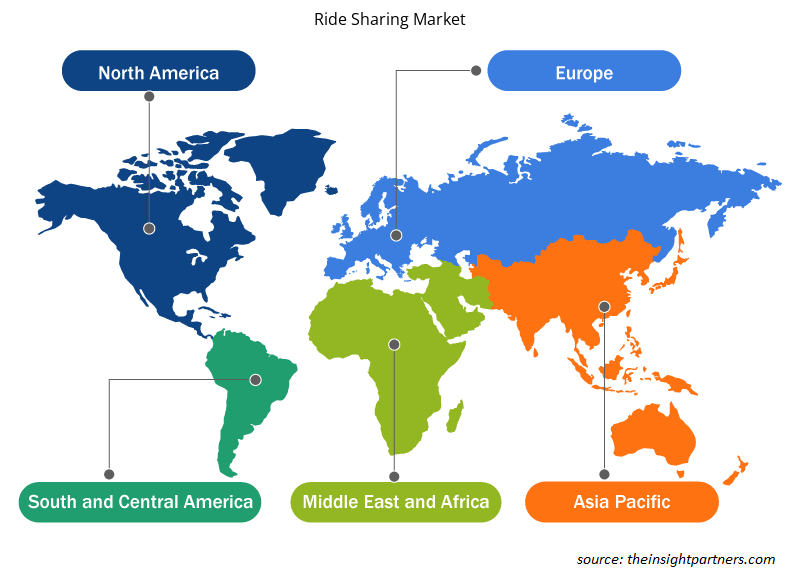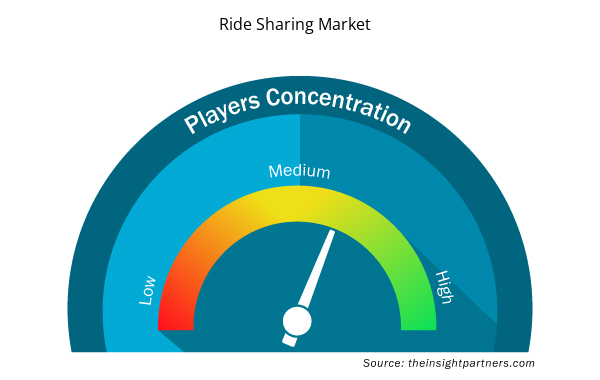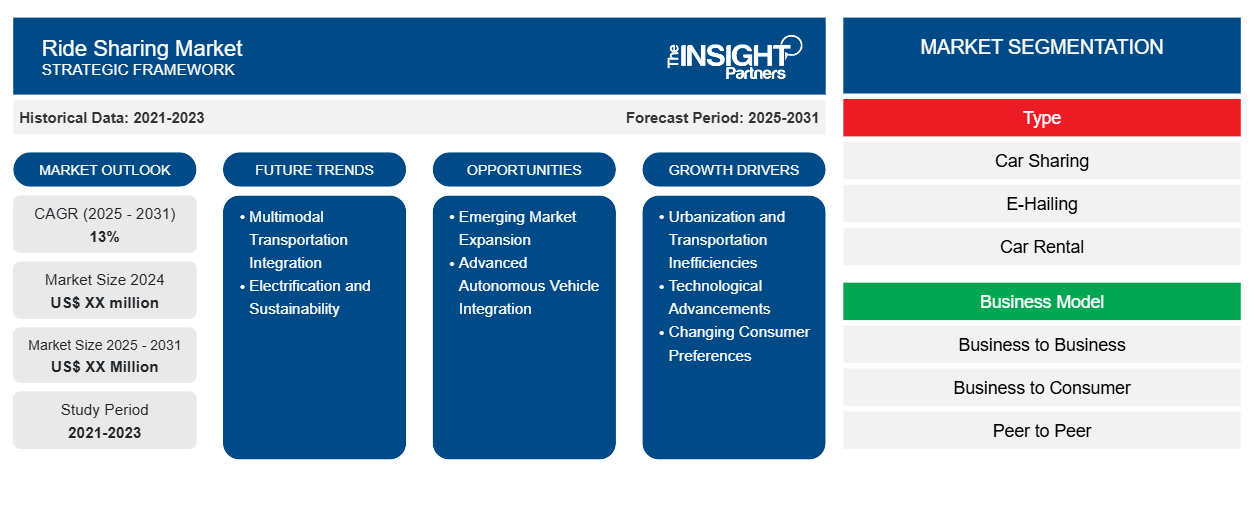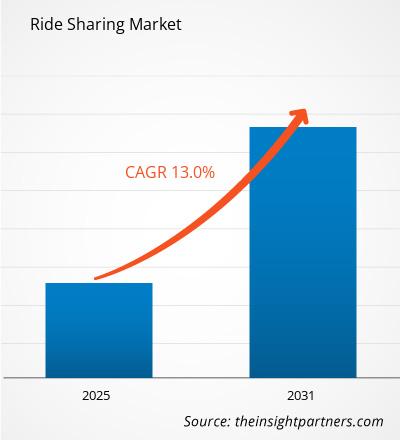Si prevede che il mercato del ride sharing registrerà un CAGR del 13% dal 2023 al 2031, con una dimensione di mercato in espansione da XX milioni di dollari nel 2023 a XX milioni di dollari entro il 2031.
Il report è segmentato per tipo (Car Sharing, E-Hailing e Car Rental); e modello di business (Business to Business (B2B), Business to Consumer (B2C) e Peer to Peer (P2P)). L'analisi globale è ulteriormente suddivisa a livello regionale e nei principali paesi. Il report offre il valore in USD per l'analisi e i segmenti di cui sopra.
Scopo del rapporto
Il report Ride Sharing Market di The Insight Partners mira a descrivere il panorama attuale e la crescita futura, i principali fattori trainanti, le sfide e le opportunità. Ciò fornirà spunti a vari stakeholder aziendali, come:
- Fornitori/produttori di tecnologia: per comprendere le dinamiche di mercato in evoluzione e conoscere le potenziali opportunità di crescita, consentendo loro di prendere decisioni strategiche informate.
- Investitori: condurre un'analisi completa delle tendenze in merito al tasso di crescita del mercato, alle proiezioni finanziarie del mercato e alle opportunità esistenti lungo la catena del valore.
- Enti di regolamentazione: regolamentano le politiche e le attività di controllo sul mercato allo scopo di ridurre al minimo gli abusi, preservare la fiducia degli investitori e sostenere l'integrità e la stabilità del mercato.
Segmentazione del mercato del ride sharing
Tipo
- Condivisione auto
- E-Hailing
- Noleggio auto
Modello di business
- Da azienda ad azienda
- Da impresa a consumatore
- Peer to peer
Personalizza questo report in base alle tue esigenze
Riceverai la personalizzazione gratuita di qualsiasi report, comprese parti di questo report, o analisi a livello nazionale, pacchetto dati Excel, oltre a usufruire di grandi offerte e sconti per start-up e università
- Scopri le principali tendenze di mercato in questo rapporto.Questo campione GRATUITO includerà analisi di dati che spaziano dalle tendenze di mercato alle stime e alle previsioni.
Fattori trainanti della crescita del mercato del ride sharing
- Urbanizzazione e inefficienze nei trasporti: la rapida urbanizzazione globale ha creato notevoli sfide nei trasporti, con una densità di popolazione in aumento, congestione del traffico e spazi di parcheggio limitati. I modelli di trasporto tradizionali faticano a soddisfare le esigenze di mobilità dinamica dei moderni abitanti delle città. Le piattaforme di ride-sharing offrono una soluzione flessibile e on-demand che affronta questi vincoli di mobilità urbana fornendo alternative di trasporto efficienti e convenienti che riducono la proprietà individuale di auto e ottimizzano la capacità dei veicoli esistenti.
- Progressi tecnologici: tecnologie rivoluzionarie come GPS, proliferazione di smartphone e algoritmi avanzati hanno rivoluzionato le capacità di ride-sharing. L'apprendimento automatico e l'analisi dei dati in tempo reale consentono un'ottimizzazione più accurata del percorso, prezzi dinamici e un abbinamento utente migliorato. Queste innovazioni tecnologiche hanno migliorato notevolmente l'esperienza utente, rendendo il ride-sharing più comodo, più sicuro e più prevedibile rispetto alle modalità di trasporto tradizionali.
- Cambiamento delle preferenze dei consumatori: le generazioni più giovani, in particolare i millennial e la Gen Z, dimostrano un cambiamento significativo nelle preferenze di trasporto. Danno priorità all'accesso rispetto alla proprietà, apprezzano la comodità e sono più consapevoli dell'ambiente. Questa fascia demografica vede sempre di più il ride-sharing come una soluzione di mobilità sostenibile e flessibile che si allinea al proprio stile di vita, evitando gli oneri finanziari e di manutenzione della proprietà di un veicolo personale.millennials and Gen Z, demonstrate a significant shift in transportation preferences. They prioritize access over ownership, value convenience, and are more environmentally conscious. This demographic increasingly views ride-sharing as a sustainable, flexible mobility solution that aligns with their lifestyle, eschewing the financial and maintenance burdens of personal vehicle ownership.
Tendenze future del mercato del ride sharing
- Integrazione del trasporto multimodale: le piattaforme di ride-sharing si stanno evolvendo oltre i singoli servizi di trasporto, integrando più opzioni di mobilità in ecosistemi unificati e senza soluzione di continuità. Le aziende stanno sviluppando soluzioni di trasporto complete che combinano ride-hailing, bike-sharing, scooter elettrici e trasporto pubblico in applicazioni coese e di facile utilizzo. Questa tendenza verso la mobilità come servizio (MaaS) offre agli utenti scelte di trasporto più flessibili e interconnesse. Transportation Integration: Ride-sharing platforms are evolving beyond individual transportation services, integrating multiple mobility options into unified, seamless ecosystems. Companies are developing comprehensive transportation solutions that combine ride-hailing, bike-sharing, electric scooters, and public transit into cohesive, user-friendly applications. This trend towards mobility-as-a-service (MaaS) provides users with more flexible, interconnected transportation choices.
- Elettrificazione e sostenibilità: il settore del ride-sharing sta rapidamente adottando tecnologie di veicoli elettrici e ibridi per ridurre le emissioni di carbonio e soddisfare le crescenti aspettative di sostenibilità ambientale. Le principali piattaforme stanno investendo in flotte di veicoli elettrici, implementando programmi di compensazione delle emissioni di carbonio e sviluppando strutture di incentivi che incoraggiano i conducenti ad adottare tecnologie di trasporto più ecologiche. Questa tendenza riflette la crescente domanda dei consumatori di soluzioni di mobilità ecologicamente responsabili.
Opportunità di mercato per la condivisione del viaggio
- Espansione dei mercati emergenti: le economie in via di sviluppo presentano notevoli opportunità di crescita per le piattaforme di ride-sharing. La rapida urbanizzazione, la crescente penetrazione degli smartphone e una classe media in crescita in regioni come il Sud-est asiatico, l'India e parti dell'Africa creano un terreno fertile per soluzioni di mobilità innovative. Questi mercati offrono un potenziale inutilizzato alle aziende di ride-sharing per stabilire una leadership di mercato precoce e sviluppare ecosistemi di trasporto localizzati.
- Integrazione avanzata dei veicoli autonomi: il continuo sviluppo delle tecnologie dei veicoli autonomi presenta un'opportunità trasformativa per le piattaforme di ride-sharing. Investendo e preparando infrastrutture per veicoli a guida autonoma, le aziende possono potenzialmente rivoluzionare l'economia dei trasporti. Costi di manodopera ridotti, maggiore sicurezza e maggiore efficienza operativa potrebbero rimodellare radicalmente il panorama del ride-sharing, offrendo soluzioni di mobilità più convenienti e accessibili.
Approfondimenti regionali sul mercato del ride sharing
Le tendenze regionali e i fattori che influenzano il mercato del Ride Sharing durante il periodo di previsione sono stati ampiamente spiegati dagli analisti di Insight Partners. Questa sezione discute anche i segmenti e la geografia del mercato del Ride Sharing in Nord America, Europa, Asia Pacifico, Medio Oriente e Africa e Sud e Centro America.

- Ottieni i dati specifici regionali per il mercato del ride sharing
Ambito del rapporto sul mercato del ride sharing
| Attributo del report | Dettagli |
|---|---|
| Dimensioni del mercato nel 2023 | XX milioni di dollari USA |
| Dimensioni del mercato entro il 2031 | XX milioni di dollari USA |
| CAGR globale (2023-2031) | 13% |
| Dati storici | 2021-2022 |
| Periodo di previsione | 2024-2031 |
| Segmenti coperti | Per tipo
|
| Regioni e Paesi coperti | America del Nord
|
| Leader di mercato e profili aziendali chiave |
|
Densità degli attori del mercato del ride sharing: comprendere il suo impatto sulle dinamiche aziendali
Il mercato del Ride Sharing sta crescendo rapidamente, spinto dalla crescente domanda degli utenti finali dovuta a fattori quali l'evoluzione delle preferenze dei consumatori, i progressi tecnologici e una maggiore consapevolezza dei vantaggi del prodotto. Con l'aumento della domanda, le aziende stanno ampliando le loro offerte, innovando per soddisfare le esigenze dei consumatori e capitalizzando sulle tendenze emergenti, il che alimenta ulteriormente la crescita del mercato.
La densità degli operatori di mercato si riferisce alla distribuzione di aziende o società che operano in un particolare mercato o settore. Indica quanti concorrenti (operatori di mercato) sono presenti in un dato spazio di mercato in relazione alle sue dimensioni o al valore di mercato totale.
Le principali aziende che operano nel mercato del Ride Sharing sono:
- Azienda
- BlaBlaCar
- Società di tecnologia Carma
- DiDi (Pechino Xiaoju Technology Co, Ltd.)
- Società a responsabilità limitata
Disclaimer : le aziende elencate sopra non sono classificate secondo un ordine particolare.

- Ottieni una panoramica dei principali attori del mercato del Ride Sharing
Punti di forza chiave
- Copertura completa: il rapporto esamina in modo completo i prodotti, i servizi, le tipologie e gli utenti finali del mercato del ride sharing, offrendo una panoramica olistica.
- Analisi degli esperti: il rapporto è compilato sulla base della conoscenza approfondita di esperti e analisti del settore.
- Informazioni aggiornate: il rapporto garantisce la pertinenza aziendale grazie alla copertura di informazioni recenti e tendenze nei dati.
- Opzioni di personalizzazione: questo report può essere personalizzato per soddisfare le esigenze specifiche del cliente e adattarsi in modo appropriato alle strategie aziendali.
Il rapporto di ricerca sul mercato del Ride Sharing può, quindi, aiutare a guidare il percorso di decodificazione e comprensione dello scenario del settore e delle prospettive di crescita. Sebbene possano esserci alcune preoccupazioni valide, i vantaggi complessivi di questo rapporto tendono a superare gli svantaggi.
- Analisi storica (2 anni), anno base, previsione (7 anni) con CAGR
- Analisi PEST e SWOT
- Valore/volume delle dimensioni del mercato - Globale, regionale, nazionale
- Industria e panorama competitivo
- Set di dati Excel


- Precast Concrete Market
- Employment Screening Services Market
- Dry Eye Products Market
- Space Situational Awareness (SSA) Market
- Single-Use Negative Pressure Wound Therapy Devices Market
- Social Employee Recognition System Market
- Vaginal Specula Market
- Occupational Health Market
- Dairy Flavors Market
- Customer Care BPO Market

Report Coverage
Revenue forecast, Company Analysis, Industry landscape, Growth factors, and Trends

Segment Covered
This text is related
to segments covered.

Regional Scope
North America, Europe, Asia Pacific, Middle East & Africa, South & Central America

Country Scope
This text is related
to country scope.
Domande frequenti
Some of the customization options available based on the request are an additional 3-5 company profiles and country-specific analysis of 3-5 countries of your choice. Customizations are to be requested/discussed before making final order confirmation, as our team would review the same and check the feasibility.
The report can be delivered in PDF/PPT format; we can also share excel dataset based on the request.
The leading players operating in the Ride Sharing Market include: Uber Technologies, Inc., Lyft, Inc., Didi Global Inc., Ola Cabs, Bolt (formerly Taxify), Grab Holdings,
Gojek, BlaBlaCar, Via Transportation, Inc., Cabify
The Ride Sharing Market is estimated to witness a CAGR of 13% from 2023 to 2031
Trend Toward Multimodal Solutions for Transportation is the key future trend of the Ride Sharing Market
The major factors driving the Ride Sharing Market are: Urbanization and Traffic Congestion#Rising Fuel Costs and Environmental Concerns
Trends and growth analysis reports related to Automotive and Transportation : READ MORE..
1. ANI Technologies Pvt. Ltd.
2. BlaBlaCar
3. Carma Technology Corporation
4. DiDi (Beijing Xiaoju Technology Co, Ltd.)
5. Gett, Inc.
6. Grab
7. Lyft, Inc.
8. Car2Go
9. Uber Technologies Inc.
10. Quick Ride
The Insight Partners performs research in 4 major stages: Data Collection & Secondary Research, Primary Research, Data Analysis and Data Triangulation & Final Review.
- Data Collection and Secondary Research:
As a market research and consulting firm operating from a decade, we have published and advised several client across the globe. First step for any study will start with an assessment of currently available data and insights from existing reports. Further, historical and current market information is collected from Investor Presentations, Annual Reports, SEC Filings, etc., and other information related to company’s performance and market positioning are gathered from Paid Databases (Factiva, Hoovers, and Reuters) and various other publications available in public domain.
Several associations trade associates, technical forums, institutes, societies and organization are accessed to gain technical as well as market related insights through their publications such as research papers, blogs and press releases related to the studies are referred to get cues about the market. Further, white papers, journals, magazines, and other news articles published in last 3 years are scrutinized and analyzed to understand the current market trends.
- Primary Research:
The primarily interview analysis comprise of data obtained from industry participants interview and answers to survey questions gathered by in-house primary team.
For primary research, interviews are conducted with industry experts/CEOs/Marketing Managers/VPs/Subject Matter Experts from both demand and supply side to get a 360-degree view of the market. The primary team conducts several interviews based on the complexity of the markets to understand the various market trends and dynamics which makes research more credible and precise.
A typical research interview fulfils the following functions:
- Provides first-hand information on the market size, market trends, growth trends, competitive landscape, and outlook
- Validates and strengthens in-house secondary research findings
- Develops the analysis team’s expertise and market understanding
Primary research involves email interactions and telephone interviews for each market, category, segment, and sub-segment across geographies. The participants who typically take part in such a process include, but are not limited to:
- Industry participants: VPs, business development managers, market intelligence managers and national sales managers
- Outside experts: Valuation experts, research analysts and key opinion leaders specializing in the electronics and semiconductor industry.
Below is the breakup of our primary respondents by company, designation, and region:

Once we receive the confirmation from primary research sources or primary respondents, we finalize the base year market estimation and forecast the data as per the macroeconomic and microeconomic factors assessed during data collection.
- Data Analysis:
Once data is validated through both secondary as well as primary respondents, we finalize the market estimations by hypothesis formulation and factor analysis at regional and country level.
- Macro-Economic Factor Analysis:
We analyse macroeconomic indicators such the gross domestic product (GDP), increase in the demand for goods and services across industries, technological advancement, regional economic growth, governmental policies, the influence of COVID-19, PEST analysis, and other aspects. This analysis aids in setting benchmarks for various nations/regions and approximating market splits. Additionally, the general trend of the aforementioned components aid in determining the market's development possibilities.
- Country Level Data:
Various factors that are especially aligned to the country are taken into account to determine the market size for a certain area and country, including the presence of vendors, such as headquarters and offices, the country's GDP, demand patterns, and industry growth. To comprehend the market dynamics for the nation, a number of growth variables, inhibitors, application areas, and current market trends are researched. The aforementioned elements aid in determining the country's overall market's growth potential.
- Company Profile:
The “Table of Contents” is formulated by listing and analyzing more than 25 - 30 companies operating in the market ecosystem across geographies. However, we profile only 10 companies as a standard practice in our syndicate reports. These 10 companies comprise leading, emerging, and regional players. Nonetheless, our analysis is not restricted to the 10 listed companies, we also analyze other companies present in the market to develop a holistic view and understand the prevailing trends. The “Company Profiles” section in the report covers key facts, business description, products & services, financial information, SWOT analysis, and key developments. The financial information presented is extracted from the annual reports and official documents of the publicly listed companies. Upon collecting the information for the sections of respective companies, we verify them via various primary sources and then compile the data in respective company profiles. The company level information helps us in deriving the base number as well as in forecasting the market size.
- Developing Base Number:
Aggregation of sales statistics (2020-2022) and macro-economic factor, and other secondary and primary research insights are utilized to arrive at base number and related market shares for 2022. The data gaps are identified in this step and relevant market data is analyzed, collected from paid primary interviews or databases. On finalizing the base year market size, forecasts are developed on the basis of macro-economic, industry and market growth factors and company level analysis.
- Data Triangulation and Final Review:
The market findings and base year market size calculations are validated from supply as well as demand side. Demand side validations are based on macro-economic factor analysis and benchmarks for respective regions and countries. In case of supply side validations, revenues of major companies are estimated (in case not available) based on industry benchmark, approximate number of employees, product portfolio, and primary interviews revenues are gathered. Further revenue from target product/service segment is assessed to avoid overshooting of market statistics. In case of heavy deviations between supply and demand side values, all thes steps are repeated to achieve synchronization.
We follow an iterative model, wherein we share our research findings with Subject Matter Experts (SME’s) and Key Opinion Leaders (KOLs) until consensus view of the market is not formulated – this model negates any drastic deviation in the opinions of experts. Only validated and universally acceptable research findings are quoted in our reports.
We have important check points that we use to validate our research findings – which we call – data triangulation, where we validate the information, we generate from secondary sources with primary interviews and then we re-validate with our internal data bases and Subject matter experts. This comprehensive model enables us to deliver high quality, reliable data in shortest possible time.


 Ottieni un campione gratuito per questo repot
Ottieni un campione gratuito per questo repot